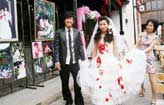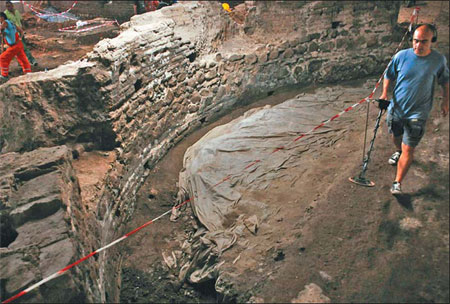Society
Roman ruins unearthed
Updated: 2011-08-16 08:11
By Diana Simeonova (China Daily)
|
An archaeologist works with a metal detector near the wall of early Christian basilica during archaeological excavations in the central trade street of the ancient Roman city of Ulpia Serdica in Sofia, Bulgaria. Nikolay Doychinov / Agence France-Presse |
 |
SOFIA, Bulgaria - Cars zoom by on the boulevards overhead as work progresses on expanding the subway underneath - and in between a full-fledged Roman city has emerged right in the heart of the Bulgarian capital.
Archaeologists have little by little unearthed well-preserved stretches of cobbled Roman streets, a public bath, the ruins of a dignitary's house and the curved wall of an early Christian basilica, all dating back to the 4th century.
If all goes well, the ruins will be fashioned into a vast underground museum due to open to the public in late 2012.
"We hope to close excavations in another month and a half to open a room for conservation and then open the complex by the autumn of 2012," excavations chief Mario Ivanov said on a recent visit to the site.
Roman ruins have dotted the capital for ages. Among these are a fully-preserved round Roman church and the sunken remains of an emperor's palace in the courtyard of Sofia's stern-looking presidency - an incongruous sight and a prime tourist attraction for years now.
The latest excavations are basically an extension of the earlier ones, and are exposing more and more of Ulpia Serdica, a Roman town - and important crossing point between Europe and Asia for thousands of years - that stretches right beneath the government quarter in downtown Sofia.
The digs picked up in the last year as the city started work on a new subway line, which is to include a major station planned right under the historical site.
Sofia Mayor Yordanka Fandakova said drafts for the subway had to be adjusted four times as archaeologists - unsure what to expect - peeled away layers that exposed new treasures.
But the adjustments should be worth it.
"Sofia will have the most beautiful and state-of-the-art subway station in Europe with 1.9 hectares of underground museum," she said.
The archaeological project was funded with 16 million leva ($11.6 million) from the European Union's regional development program.
As work progressed, two boulevards covering the site were partly rebuilt on massive concrete crossbeams to allow archaeologists, working below, to expose a section of the stone-paved Decomanus Maximus, the main street in the Roman town.
A stretch of the underground ruins will also be visible from street level through a huge glass dome.
Bordering the Decomanus Maximus, archaeologists also uncovered the remains of what is believed to be the home of an important local dignitary, complete with inner courtyard and private bathhouse.
"Due to its central positioning and two seals found in the house, we presume it was the home of Leontius, one of the bishops of Ulpia Serdica," said archaeologist Ivanov.
The building next door was a Roman bath, probably patronized by the wealthier classes, complete with an intricate heating system underfoot, pink plaster floors and some 30 square meters of well-preserved Roman rosette mosaics.
Of more than just aesthetic value, these excavations also offer a glimpse into Bulgaria's ancient history.
Digging deeper at one spot, the archaeologists uncovered the ruins of a dried brick house from the mid-2nd century as well as well-preserved wooden parts of a Roman house from the 1st century.
A furnace with traces of glass on its charred surface could also indicate early glass making in the town, which until now was thought to have imported its glassware until after the 4th century, according to Ivanov.
"Once finished, the complex will be very beautiful and become a major tourist attraction," he predicted.
Visitors should be allowed to touch the ruins and "immerse themselves in the atmosphere of the ancient town: It's different from just looking at objects on display in a museum".
They might even do so on their way to catch the subway.
Agence France-Presse
E-paper

Going with the flow
White-collar workers find a traditional exercise helps them with the frustrations of city life
The light touch
Long way to go
Outdoor success
Specials

Star journalist remembered
Friends, colleagues attended a memorial service to pay tribute to veteran reporter Li Xing in US.

Robots seen as employer-friendly
Robots are not new to industrial manufacturing. They have been in use since the 1960s.

A prosperous future
Wedding website hopes to lure chinese couples

